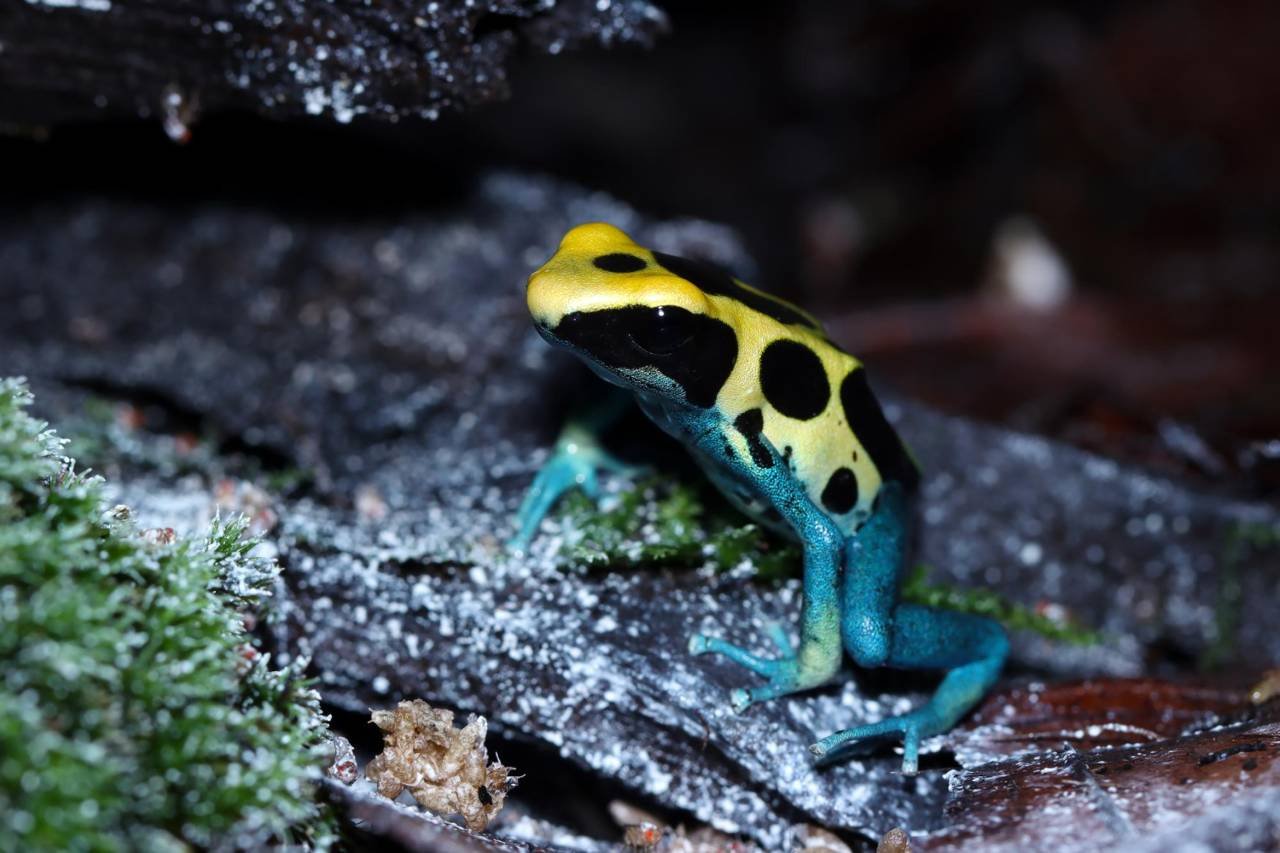The rainforests of the world are home to a rich abundance of life, including some of the most diverse and fascinating frog species. These tropical frogs are not only vibrant in color and behavior but also play crucial roles in the delicate balance of their ecosystem. Let’s explore the unique characteristics, adaptations, and ecological importance of tropical frog species.
Diversity and Habitats
Tropical frogs are incredibly diverse, with species inhabiting various layers of the rainforest, from the forest floor to the canopy. They are found in Central and South America, Africa, Asia, and other tropical regions. Their habitats include the lush understory, vibrant canopies, and the banks of rainforest streams and rivers.
Vivid Colors and Warning Signals
One of the most striking features of tropical frog species is their vivid coloration. These colors are not just for show; they serve as a warning signal to predators about the toxic nature of many species.
- Poison Dart Frogs (Dendrobatidae): Known for their bright reds, blues, and yellows, these frogs secrete toxins through their skin. Their colors warn predators to stay away, contributing to their survival in the wild.
Behavioral Adaptations
Tropical frogs have developed a range of behaviors that help them thrive in their environment:
- Camouflage and Hiding: Many species utilize camouflage to blend into their surroundings, avoiding predators and increasing their hunting success.
- Vocal Communication: Frogs use a variety of calls to communicate with potential mates, establish territories, and warn rivals. The cacophony of frog calls is a signature sound of the rainforest night.
Ecological Importance
Frogs are an integral part of the rainforest ecosystem. As both predators and prey, they help regulate insect populations and serve as food for birds, snakes, and mammals. Their presence is an indicator of environmental health, and they contribute to nutrient cycling within the forest.
Conservation Challenges
Despite their resilience, tropical frog populations are threatened by habitat destruction, climate change, pollution, and disease. Conservation efforts are essential to protect these vibrant species and maintain the ecological balance of the rainforests.
- Habitat Preservation: Efforts to conserve and restore rainforest habitats are crucial for protecting frog populations.
- Research and Monitoring: Ongoing research helps monitor population health and develop effective conservation strategies.
Tropical Frog Species
1. Blue Poison Dart Frog (Dendrobates tinctorius)
The Blue Poison Dart Frog is known for its bright blue skin, adorned with black spots. Native to the rainforests of Suriname, these frogs are highly toxic and use their vivid colors as a warning to predators. They thrive in humid environments near water sources, where they lay their eggs.
2. Red-Eyed Tree Frog (Agalychnis callidryas)
Native to the rainforests of Central America, the Red-Eyed Tree Frog is famous for its striking red eyes, vibrant green body, and orange feet. These frogs are mostly nocturnal and use their colors to startle predators as a defense mechanism. They inhabit trees near ponds and rivers.
3. Golden Poison Frog (Phyllobates terribilis)
The Golden Poison Frog, found in the rainforests of Colombia, is one of the most toxic animals on Earth. Its bright yellow skin serves as a warning of its potent toxins. Despite their toxicity, these frogs have a relatively calm demeanor and live in small family groups in humid forest floors.
4. Amazon Milk Frog (Trachycephalus resinifictrix)
Known for its striking black and white patterns, the Amazon Milk Frog inhabits the canopies of the Amazon Rainforest in South America. These frogs produce a milky secretion that acts as a deterrent against predators. They favor moist, wooded areas near streams and ponds.
5. Strawberry Poison Frog (Oophaga pumilio)
Tiny but striking, the Strawberry Poison Frog sports a vibrant red body often dotted with blue or black legs. Found in Central American rainforests, these frogs are known for their diverse color variations. They use their toxic skin to ward off potential threats and prefer lowland forest habitats.
6. Glass Frog (Hyalinobatrachium fleischmanni)
The Glass Frog, native to Central and South America, is named for its translucent skin, which reveals its internal organs. These frogs live in trees overhanging streams and are primarily nocturnal. Their transparency serves as camouflage against predators.
7. Goliath Frog (Conraua goliath)
Native to West Africa, the Goliath Frog is the largest frog species in the world. These frogs can grow up to 32 centimeters (12.6 inches) in length and weigh over 3 kilograms (7 pounds). They inhabit fast-flowing rivers and waterfalls, where they hunt for insects and small animals.
These tropical frogs represent the incredible diversity found in rainforests across the globe, each with unique adaptations that help them thrive in their respective environments.
Conclusion About Tropical Frog Species
Tropical frogs are truly living treasures of the rainforest. Their diverse characteristics, behaviors, and ecological roles highlight the beauty and complexity of these vital ecosystems. Protecting tropical frog species is not just about preserving individual creatures but safeguarding the intricate web of life that supports the health of our planet. By understanding and valuing these remarkable amphibians, we can inspire action and appreciation for the natural world.
For more on the diversity and roles of frogs in various ecosystems, you might also explore articles related to the life cycle of frogs and evolution of frogs.
FAQs About Tropical Frog Species
Where can tropical frogs be found?
Tropical frogs inhabit rainforests around the world, including Central and South America, Africa, and Asia. They occupy various layers of the rainforest, from the forest floor to the canopy.
What makes poison dart frogs so colorful?
Poison dart frogs are known for their bright colors, such as reds, blues, and yellows. These colors serve as a warning to predators about the toxins secreted through their skin, helping to deter potential threats.
How do tropical frogs communicate?
Tropical frogs use a variety of vocal calls to communicate with potential mates, establish territories, and warn rivals. These calls create the distinctive chorus that fills the rainforest, especially at night.
Why are tropical frogs important to the rainforest ecosystem?
Frogs play crucial roles in regulating insect populations and serve as prey for birds, snakes, and mammals. They contribute to the nutrient cycling within the forest and are indicators of environmental health.
What are the main threats to tropical frog populations?
Tropical frogs face numerous threats, including habitat destruction, climate change, pollution, and disease. Conservation efforts are essential to protect these species and preserve the ecological balance of rainforests.
What is unique about the Blue Poison Dart Frog?
The Blue Poison Dart Frog is notable for its bright blue skin with black spots. Native to Suriname’s rainforests, its vivid color warns predators of its high toxicity.
Where can you find the Red-Eyed Tree Frog?
The Red-Eyed Tree Frog is native to Central America and is known for its striking red eyes and vibrant body colors. They inhabit trees near ponds and rivers.
Which is the most toxic frog in the world?
The Golden Poison Frog, found in Colombia, is one of the most toxic animals on Earth. Its bright yellow skin serves as a warning to potential predators.
Why is the Amazon Milk Frog named so?
The Amazon Milk Frog produces a milky secretion as a defense mechanism against predators. They have distinctive black and white patterns and inhabit the Amazon Rainforest.
What is special about the Glass Frog’s appearance?
Glass Frogs have translucent skin, allowing their internal organs to be visible. This transparency provides camouflage in the trees overhanging streams.
How large can the Goliath Frog grow?
The Goliath Frog, native to West Africa, is the largest frog species in the world, growing up to 32 centimeters (12.6 inches) in length and weighing over 3 kilograms (7 pounds).

